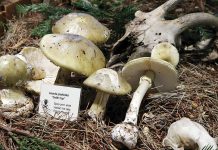Water is one of our region’s most precious resources. Our hot, dry summers have always made water conservation a top priority. With a little planning, gardeners and landscapers can reduce the amount of water that goes to weeds, while still maintaining healthy plants.
Take a look at your landscape. It looks peaceful and serene, doesn’t it? The truth is, it’s a battlefield. Each plant is fighting its neighbor for food, water and sunlight. Weeds, in particular, are survivors. Unlike many garden and landscape plants, weeds often thrive in any soil. They grow fast, shading out desirable plants, stealing water and nutrients as they grow.
So, what are weeds? Very often, weeds are the plants that survive after we try to kill them.
Sustainable weed control
Many people use herbicides to rid their yard of weeds because it is fast and easy. This is a short-term solution. Regularly applying herbicides to the same area can develop resistant varieties. Herbicides can also threaten your landscape and garden plants through runoff and wind distribution.
Most weeds can be controlled by hand weeding, good garden design, mulching and keeping garden plants healthy enough to defend themselves. Mulch also stabilizes soil temperature and reduces evaporation of irrigation water.
Smart irrigation
Good garden design incorporates proper site preparation for each plant, choosing plants suited to South Valley’s climate and installing “smart” irrigation. In areas without plantings, porous ground covers, such as permeable pavers, can allow the soil below to breathe and receive rainwater. These practices work together to reduce weeds and to conserve water.
Smart irrigation means improving watering efficiency and distribution to ensure the water goes where it is needed and not to the weeds. Drip irrigation, smart irrigation controllers and rotor heads, and soaker hoses can significantly conserve water. Plants that use a lot of water during the summer, such as roses, can be watered with plastic jugs buried in the ground. Simply cut the bottom off a 1-liter plastic bottle. Dig a hole a little deeper than the bottle and fill the bottom 1 to 2 inches of the hole with gravel or rocks. Place the bottle so that only the small opening on top is above the soil line. When it is time to water, use a hose to fill the bottle. This prevents watering weeds and it gets the water to the root system, where it will provide the most benefit.
If an irrigation system is already in place, be sure to check for leaks. Putting water where it will do the most good, in a way that reduces evaporation and runoff, will ensure that South Valley gardens have the water they need.
Kate Russell is a UCCE master gardener. You can learn more about weed management at http://www.ipm.ucdavis.edu/PMG/PESTNOTES/pn7441.html. You can also contact your UCCE Master Gardener Hotline by calling (408) 282-3105 or submit questions at www.mastergardeners.org/ask-a-question.
Putting water where it will do the most good, in a way that reduces evaporation and runoff, will ensure that gardens have the water they need.













